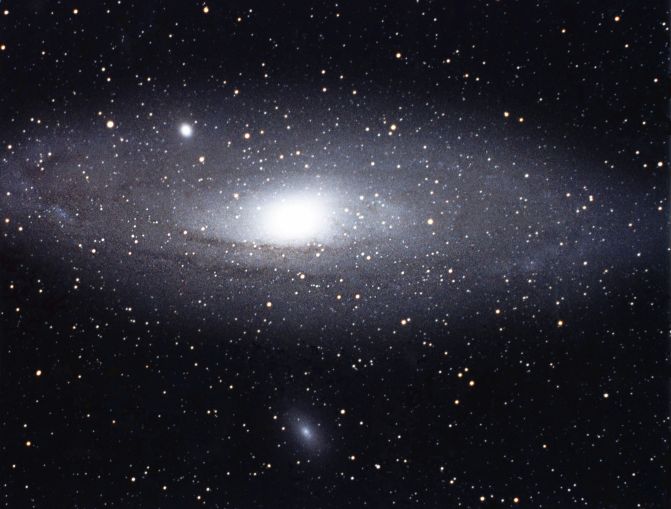
The Andromeda Galaxy can be seen with the naked eye. Because it is visible with the naked eye, the Andromeda Galaxy appeared on star charts long before the invention of the telescope. It was known as far back as 905 A.D., and was mentioned by early Persian astronomers. Charles Messier listed this object as number 31 in his catalog, but Simon Marius is given credit for being the first to observe this galaxy with a telescope in 1611 or 1612. Early observers thought this object was a nebula, possibly representing a solar system in its formation. In 1923, Edwin Hubble (for whom the Hubble Space Telescope is named) proved conclusively the extra-galactic nature of the object. V.M. Slipher at Lowell Observatory was the first person to measure the radial velocity of this galaxy in 1912. His research was performed using photographic plates, and he had to use exposures of up to seven hours with a 24-inch refractor in order to make the radial velocity measurements. Of course, Lowell Observatory is also credited with the discovery of Pluto.
M31 shines at magnitude 3.5, and can even be detected under moderately light polluted city skies. Under dark skies, the outer glow of the galaxy is much easier to detect, and the visible size of the object increases considerably. With binoculars, the galaxy appears as an elongated faint hazy glow. With a moderate size amateur telescope, you can see the first dust band shown in this photograph. However, long exposure photographs or CCD images reveal the galaxy in all of its glory. This spiral galaxy contains over 300 billion stars. The spiral arms contain bright blue giant stars, while the central core contains fainter red and yellow stars. The companion galaxy visible below M31 is known as M110. The galaxy M32 is the bright spot above and to the left of the core of M31.
This photograph was taken with a Takahashi FS-128 refractor using a reducer at f5.9.
M31 (NGC 224)
Constellation: Andromeda
RA: 00h 42m 44s Dec: +41d 16' 08" (J2000)
November 1997
Photo by Sid Leach
Iola, Texas
Recent Images.
Complete list of images.
Description of equipment used to acquire images.
Home
Feedback and comments should go to Sid